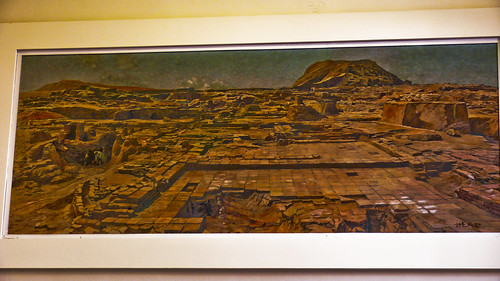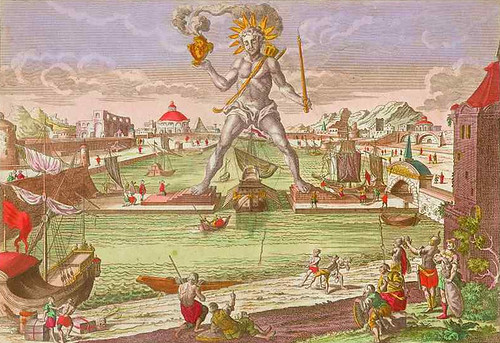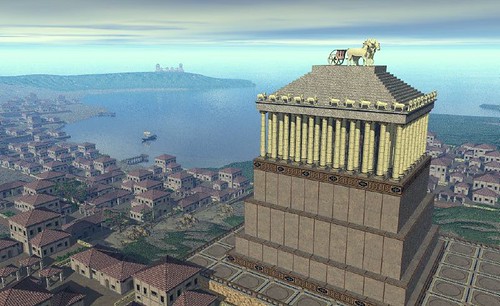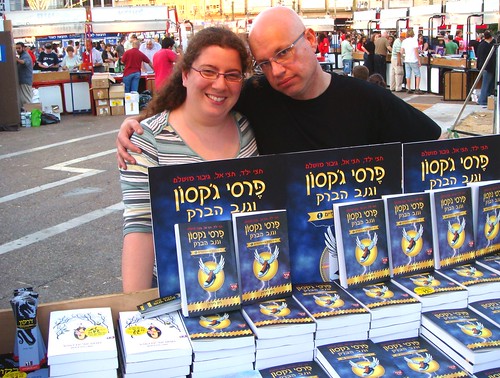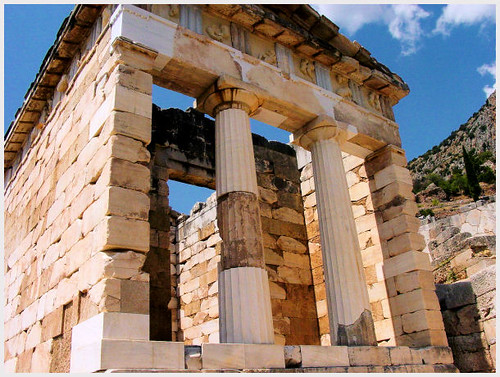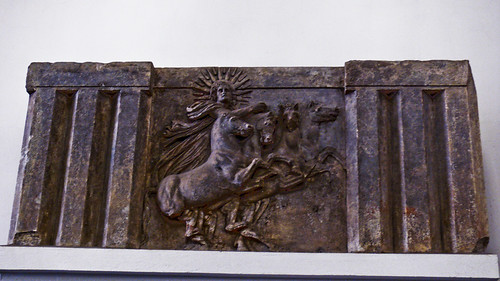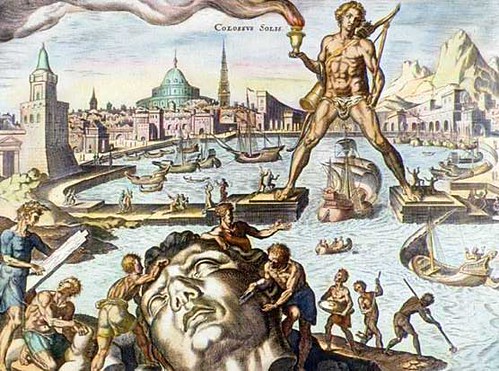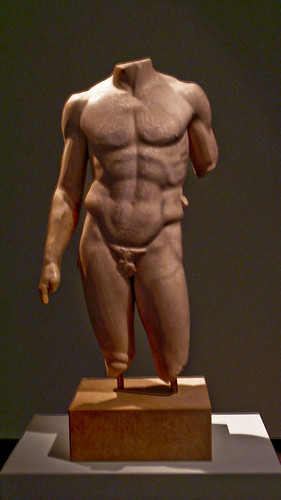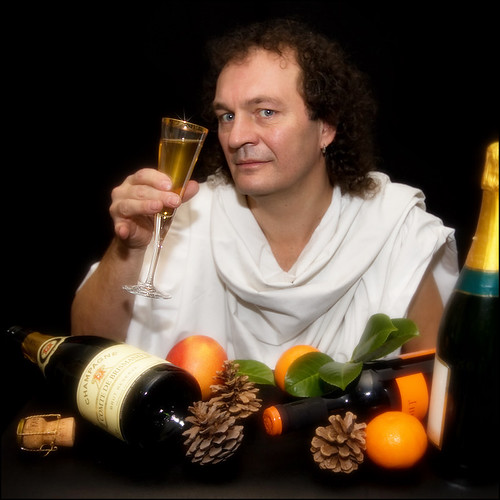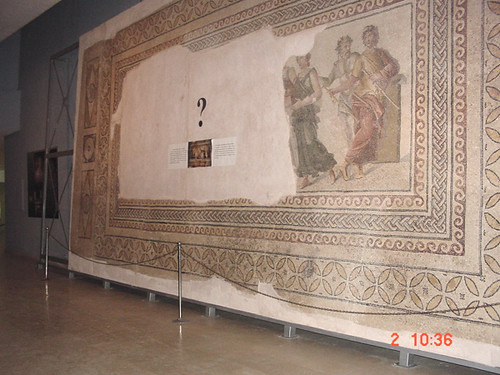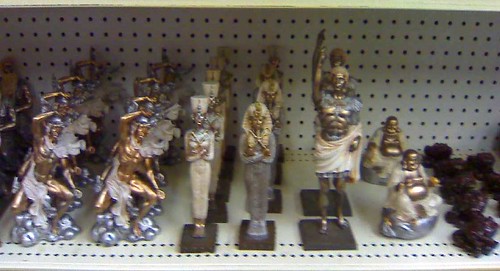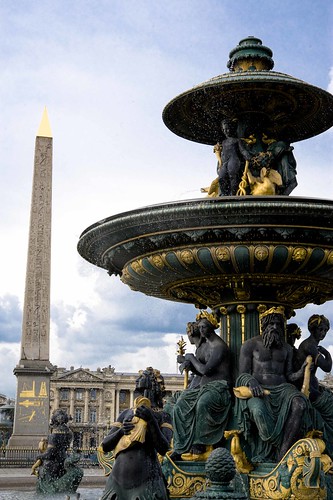
Image : http://www.flickr.com
Sadequain is a great thematic painter of Pakistan. He has worked in various styles ranging from linear to 'painterly' ones. Since he is a thematic painter with personal and individual observations of life, he opts to depict grotesque elements from inner and outer world, to find truth and reality. In this pursuit, he paints his canvases with figures which actually are characters taken from religion, history, mythology and literature, with backgrounds suggesting either the time period they belong to or the inward feelings they are spellbound with. The diversity in Sadequain's work, both in technique and in thought, encompasses the wide range of influences and inspirations owing to different reasons and circumstances, the artist comes across throughout his life.
This paper will analyze the influences and inspirations that effected Sadequain's art, intrinsically as well as extrinsically, to find out the sources and origins which generally cover mythology, religion, philosophy, drama and literature. This study will also unfold the influences of art movements or styles that inspired Sadequain's art.
These inspirations and influences have served and fed Sadequain's art in a manner that enables him to extract his themes from a variety of subject matters from gods and goddesses to the great thinkers and philosophers of Greece and Persia, in terms of characters, while in connection with literature, he touched Sophocles on one end and Shakespeare, Iqbal and Ghalib on the other. Whereas by composing his frames in a theatrical way, Sadequain has put on show conceptual as well as corporeal aspect of drama in life, an element that Baroque art is famous for.
Most of Sadequain's paintings display elements like; exaggeration, horror, metamorphosis, drama and myth in their themes while as far as figures or characters are concerned, he has looked back into history, religion and mythology (regardless of origins i.e. Greek or Indian) to portray characters that can enrich and elaborate his themes, for this purpose Sadequain has painted, celestial figures, philosophers; who had great ideology and impact like Aristotle, Socrates, Ibn-i Khaldun, scientists ranging from early periods of enlightenment like Ibn-i Haisam, al-Khwarzami, or Ibn-i Sina, to the modern era of twentieth century known for new theories, where his brush personifies Einstein or Karl Marx.
Taking his themes into consideration first, we can find him a lover and admirer of the darker and crude form of life contrary to the beautiful, subtle and aromatic aspects. Since this concept of grotesque or malamat2 is not a new one in this part of the world as it has been discussed and displayed on various levels by different schools of Sufism that has got popularity in the subcontinent.
According to Akber Naqvi:
"Sadequain's art enacted the drama of malamat in its Zahiri3 and batini4aspects-the coincidence and confusion of appearance and reality as awareness of truth in the definition of the self."
(Naqvi 370-71)
The concept of Malamat has been in vogue in the Sufi tradition here in the subcontinent, where Sufis were not of view to adapt themselves to the clear and straight rules of life, rather they groped the reality through grotesque and more ritual way of life where, dance, music, intoxication and supernatural ambiance was created and strongly believed.
With this approach in life, Sadequain is expected to reveal the realities of life through dance, drama, and rituals in an ambiance, far fetched from the physical world and close to the mystic vagueness. These subjects help him in carrying out paintings with subjects matter taken from mythologies, and enactment of the rituals, which ultimately causes him in putting dynamism within his frame along with the concepts he painted upon.
In his thirst to paint themes under the inspirations and influences he has admired throughout his life, Sadequain is seen quenching his desires, through romantic and modern painting styles and concepts when he paints with self-conscious approach and themes (a romantic attitude) at one place while with abstract expressionism and symbolic style at the other. He also follows modern art techniques, wherever needed to give expression to his inner and individual thoughts.
As his interest has never faded out of mythological and religious concepts and literary epics and stories, from where his characterization has gotten enriched, he is also found indulged in emphasis, exaggeration, hyperbole, horror, theatricality (action, drama, movement), and dynamism which reminds us of the art of baroque style. Collectively, Sadequain was inspired from diverse influences that prevailed either in European art and literature or in the Eastern tradition of grotesque mysticism (Malamat).
Historically, man has recorded his rituals, dance and religious practices of great importance in the form of cave painting; the oldest form of expression. Most of the cave paintings do possess the chronicle elements ever since those paintings have captured a performance or an activity that was related to some ritual or religious doctrine, or the adventures and hunt scenes, which can give the impression that man has always been curious to record whatsoever was around his physical and emotional existence. This practice has been the most common and respected one even in the Stone Age in the subcontinent, which has enabled us to have an idea of life and beliefs that those people were leading and following.
The earliest images in the caves of Bhimbetka with simplicity in drawing, linearity and movement of the figures, suggest the dance or hunt movements of the characters; an expression that was later partially adopted by Sadequain.
Another ancient but comparatively modern concept of religious themes and personification of sacred figures through different forms of visual art could be found in the times of Buddha. The visual expression of Jataka Stories5, which were carved in stone at the Stupa of Sanchi and Amravati, or painted on the rocks of Ajanta Caves, served the religious beliefs to be converted from intangible form to the tangible shape. These stories, at the same time provided materials for actors and dancers of Ashoka6 period (268-233 BC) to act upon.
"Jataka stories can be described as an 'encyclopedia of contemporary Indian life' in all its aspects. These stories describe various previous births of Gautam Buddha and instructive episodes relating to them.... According to Buddhist tradition, the number of these stories is 550 out of which about 547 are available in a collection. Their delineation in stone forms a major part of early Buddhist art down from Ashokan times. Many Jataka stories are artistically engraved on the stone railings and toranas of Buddhist monuments such as those at Bharhut, Sanchi and Amravati stupas and are painted on the walls of Ajanta canves. They present an approximate panorama of Indian life between 600 BC to 300 BC."
(Varadpande 116)
Since visual art is a record of events that have got immense importance in modern times, painting in particular captures figures, scenes, subjects or emotions that have been in existence prior to the moment of their rendering by the artist; so, there is possibility of overlapping of characteristics from one genre to the other. Therefore, the mythological and religious stories, characters, and moral values can get place in the paintings whenever they are rendered regardless of time. Art could adopt its characters and atmosphere from the religious doctrines, mythological concepts, literary ideas and folklore, which would be in fashion at the time, that art has been produced. As the extrinsic references have shown this quality of art as inevitable, Sadequain's art, on specific ideas of mythology (Indian or Greek), religion and poetic expressions of Iqbal7, Ghalib8 and Faiz9, clearly indicates the contrast and diversity of nature in connection with social and religious life, related to certain circumstances.
Characters have always been the main feature in visual expression, in painting; they embody tragic and joyous emotions, representing life itself. But owing to its strong appeal and gripping nature, tragedy has got pivotal place in the life of human beings and a strong motivational force for any kind of natural expression.
Aristotle argued in the Poetics that tragedy:
"is a representation, not of men, but of action and life, of 'happiness and unhappiness' and that 'happiness and unhappiness' are bound up with action"
(Aristotle 39-40)
As tragedy, according to Aristotle, is the most important factor behind any creation or expression which leads one to 'catharsis10' and enhances the total impact of 'happiness' or 'unhappiness', the embodiment of these emotions are; characters who represent these emotions through their gestures, facial expressions and movements. Any kind of expression in art gives so much importance to the characters that are going to represent the subject or the theme of the artwork. In painting, characters are represented through figures and portraits, which reflect the desired emotions and convey them to the audience through the formal quality and variation of colour, texture, chiaroscuro, line and composition.
What importance of human expressions, in visual art, is well defined as under by Goodman:
"what is expressed is metaphorically exemplified"
(Goodman 85)
Through an art such as figurative or portrait painting, expression is achieved by imitating a figure or portrait of a well-known or ordinary person or character. Keeping in view the fact that human concerns are always behind any kind of artwork, one can assume the subject matter of a certain era.
Sadequain has dealt with his paintings in terms of characters, facial expressions, distortion, movement, texture, chiaroscuro and a planned and directed atmosphere, created through the collective representation of all the mentioned elements on a larger scale. His characters, in most of his paintings are 'alive' and dynamic in nature, busy in their work or duties. They do not seem to be posing or idle for the sake of painting only. He has also used facial expression of his characters within the frame to enhance his expression of the theme that is behind that painting. By distorting figures and other elements of the painting, Sadequain has always tried to get the desired effects of human struggle, and has put his idea or theme on a high pedestal in a loud style; as on stage, with the distortion of sound effect, the director of an act creates ambiguity to clear or prominent his theme or subject. His figures are actually characters of his themes and individuals full of energy, painted to convey movement or activity, according to the subject. Sometimes in his desire of conveying his concept or theme to the viewer with energy, Sadequain has also added symbolic expression with little or more exaggeration which has, in many of his paintings and drawings, created an 'abstract expression' based on ones innate and psychological experiences that can put his work under the label of 'modern art' while his self-centered approach has fashioned 'romantic' approach at the same time.
Texture and chiaroscuro are the vital elements of a painting to create the atmosphere or ambiance, Sadequain with his cross hatching brush, using dark and light areas, creates low degree of chiaroscuro. His paintings do no possess the dramatic light effects or light and dark contrasts as of some baroque style paintings by Caravaggio11, but even then his textures create an effect of 'light and dark' to suggest the positive and negative aspects of his themes. He is a romantic at some place, and modern at the other or both, at the same time. If we take him as 'romanticist' first, he is found to fall in this category due to some reasons.
As Jacquez Barzen states:
"As against poetic diction and 'noble' words, the romanticists admitted all words; as against the exclusive use of a selected Graeco-Roman mythology, they took in the Celtic and the Germanic; as against the uniform setting and tone of classical tragedy, they studied and reproduced the observable diversities known as 'local color'. As against the antique subjects of and the set scale of pictorial merits prescribed by the Academy, they took in the whole world, seen and unseen, and the whole range of colors."
(Barzun 59)
By analyzing these qualities of romanticists, we come to a point that romanticists were against restrictions and geographical bounds, first in terms of information and knowledge and later, in their expression, they were with an opinion that myths, legends, poetic expressions, pictorial merits and concepts were universal and they had nothing to do with a certain ethnicity.
By these standards, we can call Sadequain a romantic, as he adopts everything whatever he thinks to fulfill his pictorial and conceptual requirements. He goes for the mythology regardless of its origin; he takes on the journey to diverse ethnicities and derivation while painting his canvasses. He is also an observer of the whole world and universal pains, the humanity is exposed to, and rather than classical set patterns, he has also taken up the 'observable diversities' in creating his 'local color'.
Barzun has commented between classic and romantic as:
"In common speech certainly, the sentiments aroused by the word 'classical' are those of repose and serenity, while the connotations of 'romantic' suggest restlessness and disorder."
(Barzun 37)
If we apply the conditions of restlessness and disorder on Sadequain's art and personality, the same result we can find which may advocate us to call him a romanticist. As we find his work against the static and acclaimed standards of academic art (even in a developing country like Pakistan), disorder, especially within his distorted figures, crudeness of form, and the dynamism, and the shades of restlessness, force us to label him as 'greatly inspired by romanticists' if not a romanticist himself. Sadequain's own conception of life, which is also very much individual; the grotesque or Malamati, has caused a great deal of self-centeredness when he paints self-portraits within a painting or a drawing. The symbol of 'cactus' he has used for his life also refers to the individuality covered by the ego of a self-centered individual, who seems inspired of the romantic approach of inner and individual expression. The admiration of restlessness has made him quoting Iqbals concept of true Muslim (Mard-e Momin) in pictorial way; a well-known aspect of Sadequain's work regarding inscription based painting. Other than Iqbal, he also painted upon the ideology presented in Ghalib's verse, which is a direct extraction from the Persian tradition of egoistic literary expression, of which Ghalib has been proud.
In other words, contrary to the stationary and idle attitude (which is demarked as 'classic' in the west), Sadequain prefers movement and dynamism, and for that, he even goes for the associated disorder, that is obvious in his figurative distortion, this practice has proved him immensely inspired by the impatience romanticists are known for.
Moreover, Sadequain is also a modern artist, one of the reasons for this is his period, as he was born just after the World War I and saw World War II in his youth in a colonial country where agitation was on its peak by that time. He started work when the entire world was experiencing revolutionary changes, ideological as well as geographical, with new economic and philosophical theories were helping Communism12 and Socialism13 to spread around the globe. Individuality and self-respect was the new world order and it was farewell to slavery. Either it was physical or intellectual. Freedom of thought, expression, and beliefs made self-consciousness a common and accepted doctrine that strengthened the concept of 'abstract expressionism' and individual perception.
"The first striking trait of the modern ego is self-consciousness, I say self-consciousness rather than self-awareness, because I believe that in spite of much heart-searching, the modern ego is more concerned with the way it appears in others' eyes than with learning fully about itself and admitting its troubles fearlessly. The romantics were introspective, too, but they did not fear ridicule as we do, which is why we accuse them of indecently exposing their innermost souls."
(Barzun 117)
So, Sadequain is influenced and inspired by the modern ideology of self-consciousness as well. And if we could try, in the light of quoted paragraph, to put him under the category of self-consciousness or self-awareness, he would fall in the former one. But since he accepted so many diverse influences, it will be hard to categorize him under one label, but keeping his time in consideration and the approach he adopted towards life, we could say that he was more inspired by the romantic and modern ideology of painting at the same time while his work was a crucible of different inspirations and influences, regardless of origins and ethnicities.
Other than his paintings, the drawings and sketches in 'pen and ink' could also be categorized with the same qualities that could be identified as extracted from historical, mythological, religious or literary backgrounds. In his sketches, one might not find the chiaroscuro or the 'painterliness' due to the linearity of the technique, but the entire range of pivotal conceptual elements, he has used in his paintings, could be found in extremely skilled fashion.
A drawing in pen and ink under the title 'Some other things to care about (1966)' displays probability and action in its composition which, in two groups, exhibit the arrangement of an atmosphere where something is going to happen. The artist has given proper space between the two groups that may suggest the likelihood for some action as two figures are arranged in the right corner and three webbed figures in the left, but all in such a perspective that the space within and around them is visible to the onlooker. The webbed figures put on show the drama and the grotesque approach of the artist who seems concerned in portraying the pain of human beings since their birth to the eternal abode. A religious and mythical concept mostly portrayed and depicted in scriptures, mythologies and literature or in the form of holy ritual dance or the proper theatre in Athens performing Sophocles' play.
Another painting 'Two Graces (from aesthetics) 1970', in pen and ink is like gratitude by Sadequain to the great western painting 'Three Graces'. As the idea of this painting is the same as of the mythological painting by Rapheal in the early sixteenth century or by Picasso, later in the twentieth century. The movement, drama, and the characterization come by design within the frame. The stretch and the elasticity of the female bodies are endorsed as well as captured by arranging them in dance-like postures. The festivity and the lyricism have made this drawing a rhythmic performance. This work speaks high of the Western influence, Sadequain may have been under as one of many inspirations he has been exposed to.
Another pen and ink 'The snake charmer (from observation 1970)'displays the aboriginal subject but Sadequain has, with folk subject and sensuous rendering, attracted the viewer. Moreover the combination of female body and the twirling snake, the concept of Vishkannya14seems obvious behind the painter's imagination. The character of Vishkannya is associated with dance, while the curling, twisting and creeping movements of the snake, along with the venomous myth regarding Hinduism, help in creating a conceptual story as soon as one looks upon it. All these aspects make this painting 'Thespian15' in its physical as well as conceptual approach. Sadequain's involvement in the Hindu myth and the grotesque attitude towards life, attracted him towards horrifying, dynamic and exaggerated topics and themes (a semi baroque influence), especially when he was not illustrating poetry as his first choice.
Two more pen and ink drawings 'Soul and Body (from society and the stranger 1970)' and 'The Webbed (1966)', also demonstrate the thematic drama and the symbolic rendering by the artist. In 'Soul and Body', the painter by personifying the non-corporeal subject of soul into corporeal existence of body through conceptually abstract and practically tangible practice of painting, has successfully put forth a vibrant show which may be considered a step towards self-realization or self-consciousness, as a romanticist, while through exploring the depths of inner world with reference to the outer one, he could be seen as an artist inspired by the modern theories of 'expressionism' based on the Freudian16 theories of psychology.
'The Webbed' is also a drawing with an overstatement by the artist, being caught in the desolation. Here too the painter has embodied an abstract feeling through a concrete symbol of web. The human struggle has been put in focus with the suggested movements through the cognate linearity. His comprehension of life is on a subtle point where he wants to give voice to his gruesome experiences, for that the painter is found busy in painting distorted figures, putting voice to his innate feelings and experiences, the artist has always been vulnerable of.
Akber Naqvi has stated this experience of Sadequain in these words:
"He dealt with truth and illusion at more than an aesthetic level; he remained engaged, throughout his life, in pain and in sickness."
(Naqvi 365)
Other than his sketches and drawings, his paintings also display influences of diverse origins as stated in the beginning of this paper. One painting 'Quest for knowledge (1959)' presents distorted figures, dramatic arrangement (composition), and movement. Especially the characters clad in Egyptian robes on the horse back, going after the book of knowledge, depict an exaggerated approach of the artist which ultimately has added dynamism within the frame and the effect that the figure on a galloping horse will just get out of the frame from the left side, implies an event being enacted. Symbolic, romantic and expressionistic approach could be seen at a time while Sadequain's work seems greatly inspired by mentioned art movements.
Another painting 'The eternal female (1962-63)' with distortion of the female body into a monstrous creeping creature advocates the mythological characterization, especially with reference to the aboriginal Hindu culture where the gods, goddesses and demons are portrayed with distortion and exaggeration in human or animal anatomy. The mythological treatment put on show the dramatic rituals, which have been part of sacred Hindu traditions as the Hindus have depicted almost each and every myth of Ramayana17 or Mahabharata18 in the form of famous dance-drama like Kathikali19 or Bharatnattyam20. The rudiments of 'Natak21', with supernatural characters and the element of horror, as the bizarre theme behind the painter's mind, are obvious in this piece of work. Moreover, metaphorical and exaggerated approach and theatrical mode help us understanding the linkage of Sadequain's perception with Indian traditions of expression and the forms of expressions all together, at an intrinsic and extrinsic analytical level.
A large mural painting at the State Bank Building Karachi under the title of 'The treasures of time' displays the historical and chronological qualities. This painting seems a tribute to human achievements and evolution with portraiture of geniuses from history, covering time periods from the Stone Age to the modern world. The panel painting is divided into four groups exhibiting four different eras of enlightened humanity through virtue and wisdom. In this painting, Sadequain looks greatly inspired by the revolutionary paintings of the modern art where the core reasons and the conceptual renderings were given more space.
Starting from the ancient world, Sadequain has painted the characters of Aristotle, Socrates, Plato, Archimedes, Herodotus, Sophocles and Confucius. This group shows the philosophers busy in pondering, writers and mathematicians tiring for their goals, the atmosphere created by the background, suggest the city of Athens and some part of China. The whole painting seems like an act of the drama where the well-known thinkers and philosophers are performing, reminding the all famous line by Shakespeare;
"All the world's stage."
The second group in the same gigantic painting exhibits the famous Buddha and the Galileo, an astrologist. The painter has emphasized on the details in dress, architecture and texture, while the style seems very western in this panel since detailed realism is obvious.
Third group or act of this huge painting consists of the wizards from Arabia and Persian, the origin and cradle of the Muslim doctrine and ideology. With Avicenna, Al-Khwarzmi, Ibn al-Hasam, Ibn al-Hayan, Farabi, Firdausi, Al-Kundi, Ibn-i Rushd, Rumi, Al-Idrees and Ibn-i Khaldun, busy in their respective activities, the painter looks as if he is under nostalgic infatuations and trying to glorify the events and persons of the era bygone, here again the painter has adopted a romantic attitude and have also practiced it in a romantic manner, where he also seems looking for his own individuality within these great personalities. In this group, it appears that the composition, characters and their costumes have been changed according to the painter's own conceived requirements. Here on the upper areas behind the figures, light is cast on dramatically to spot them and their importance, which reminds us the dramatic light effects of Caravaggio in his biblical and thematic paintings of late sixteenth century.
In the fourth group of this panel, the painter has tried to cast his spot light on the genius of the western world, famous figures like, Leonardo da Vinci, Newton and Goethe put diversity and an evolved historical chronology of the European pursuit of wisdom through art, philosophy and science. The architectural background here changes as the set changes behind the performers while the theatrically postured figures put forward the idea of change in embryonic time.
Keeping the pace alive, Sadequain paints the sixth group with Iqbal, Einstein, Tagore, Karl Marx, Walt Whiteman and Darwin, as the spotlight is cast to highlight the 20th century modern theories of wisdom and philosophy around the globe. The whole panel, in figure arrangement, kinesics, postures, facial expressions, and the chronology, put forward a sense of dynamic composition and ambiance, within the whole panel and from one group to the other.
No artist could conceive an idea without prior concepts and knowledge that prevails through his mind and thoughts therefore, inspirations and influences are inevitable. One generation after experiencing diversity of life in thoughts and action, pass on the evolved wisdom and knowledge to its descendants. Sadequin was born when the entire world was on the brim of change in terms of economic and political scenario as two world wars have changed the shape and the course of the history and geographical boundaries of the globe. New theories, based on science and technology were in fashion and modern ideas in philosophy and psychology were challenging the centuries old traditions. All these elements were casting deep shadows on almost all branches of knowledge and all forms of art. Sadequain has witnessed the modern art movement at its zenith and the beginning of the post modern. But at the same time, owing to his own circumstances and geographical and conceptual linkages, he observed the indigenous traditions of expression, which were deeply rooted in the soil of Indus Valley.
Religious doctrines of Islam and Hinduism also inspired him with its association with the richness of Persian traditions and the rhythms of Vedic experiences, respectively. The diversity of cultures that the subcontinent absorbed to the maximum, with an acculturation of Arabian, Persian and local Jain, Hindu and Buddhist ethnicities, also inspired his concepts to a level of grotesque evolution. In view of the fact that subcontinent was under the British rule, Sadequain, under the western influential art movements like, romanticism, modernism and tinges of Baroque elements like horror, exaggeration, metamorphosis and theatricality, moved on to blend the western influences with the indigenous concepts derived from the epics like Mahabharta and Ramayna, while the Persian poetic ideology of Rumi and Firdausi reached him through the verses of Iqbal and Ghalib.
So by painting myths, religious doctrines (although through Malamat), poetic ideas, and epic characters, in symbolic, romantic and modern way and technique, Sadequain has given vent to varied inspirations and influences that were always behind his collective as well as individual conscience. Even in his aboriginal approach, since he is a Bengali by origin, educated in India and settled in Karachi (Pakistan), he experienced all the shades of diverse cultures; he had been living in, from Bengali-Muslim to Hindu-Indian to Muslim-Pakistani. A crucible, he became, as an artist within his approach and thought. That is why his works do not present a single shade of one individual when seen collectively.
